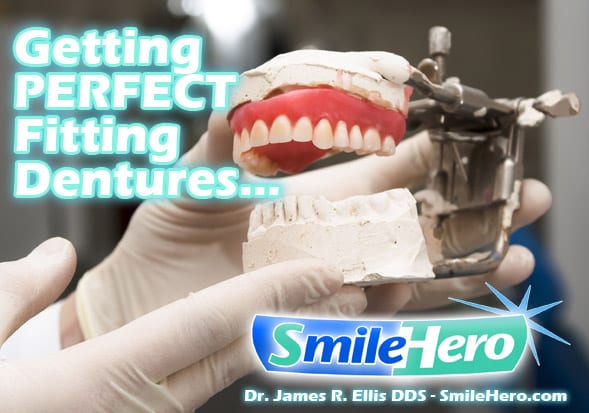The Perfect Fit Denture. How do you avoid a “Perfect Storm” in your mouth?
There are many forces that have to come together to attain a successful denture fit.
Ernest Hemmingway once said “no man is an island” or basically man cannot exist alone, he is dependent at some level on forces outside his control. In the same way, there are many hidden steps or forces inherent in not only making a denture but ultimately receiving a denture that is aesthetically pleasing and functional: a denture that allows you to talk, smile and chew.
So how are dentures constructed? You could say there are five easy steps with a hundred things that can affect the outcome:
- Get an impression: duplicate your mouth to build the denture outside your mouth
- Record the position of your Jaw, Lips and Teeth
- Select teeth and create the biting position that is comfortable and pleasing
- Try-in a wax mock up of the denture with teeth
- Process Adjust and Deliver the finished denture.
Step One. There are a lot of different ways to get an impression. The materials generally shrink after the impression is made and the plaster used to make the model of your mouth expands as it sets. So the trick is to get a balance of materials that cancel out each other.
Furthermore, when you bite, the gum tissue is compressed, so a static material that misses the compression may not work for someone with thick or movable gums.
In making the impression, using a “One Size Tray Fits All” approach to hold the impression material creates more problems than the time it saves. Custom trays with the right impression material allow for a good impression of the gums and identifies where the muscles, ligaments and lips limit what the denture can cover without being popped out when things move
Step Two. No two jaws move the same. Some are narrow, some wide, some high…you get the idea. Not only that but the right and left sides are different. So every denture is different to match the position and movement of the jaws. Recording those differences can be easy or hard depending on the skill of the denture wearer and the dentist. Many times the selection of the chewing teeth depends on how the jaw moves.
Step Three. Picking out teeth Leonardo daVinci had his secrets concerning the size and placement of a smile. So did the Gomer Pyle character created by Jim Nabors. Leonardo created a beautiful lady with the mystery smile and Jim Nabors created a dumb smile that implied a low IQ but puppy dog loyalty. The placement of the teeth creates the personality and persona of an individual.
Once the smile is determined, choosing the right chewing teeth determines the comfort of the bite. When the teeth move out of a central biting position to the front or side, the teeth need to stay in contact or occlude. This allows chewing without interference. Some teeth are flat some very steep. What is right for you depends on all those things in step two.
Step Four. The try-in. If all the previous steps worked well this step can be very easy. If not, that “Denture Storm” is only one step away. Now is the time to check out all those Leonardo tricks. Are the pupils of the eyes level with the teeth? Does the lip droop? Do the corners of the mouth or nose slump? Does it look like you can eat corn through a fence or look like you were punched in the face? If any of these things have occurred, then it is back to Step two or at least correcting something that happened during the previous steps.
Step Five. Getting the new set. Technology is a wonderful thing. Almost everything used to make dentures was adapted from another technology. The Acrylic resin used to make Dentures is very similar to the plastic used in Airplane windows. The plaster for the molds is similar to that used for surfacing swimming pools and the impression materials were used to make gear molds. When different materials are used together there can be a synergy that can be better than any one part. This is certainly true in making dentures. But just when everything is almost ready there is one final hurdle.
The last big problem is the Acrylic. It shrinks four percent (4%) during curing and leads to a denture that is too tight or won’t go all the way in. If the acrylic is cured faster, it will shrink more. If the acrylic has a built in catalyst (self-cured) the material will not only shrink more, it will discolor more over time and is not as strong as the slow cure heating process.
Getting the denture to fit requires adjustments to compensate for the shrinkage of the Acrylic and compression of the gum tissue and limits of the original impression.
Once you have the new set of dentures go out and enjoy. . But remember that compression of the tissue will change the fit and bite over the next 24 hours so more adjustments are likely. No stormy weather ahead just clear sailing from here. Happy chewing.
Tags: Caring For Your Smile, dentist, denture, denture fit, dr. ellis DDS

 August 2nd, 2011
August 2nd, 2011  admin
admin 